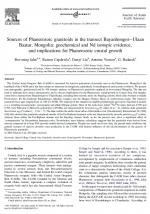Добрый день, Коллеги. Важное сообщение, просьба принять участие. Музей Ферсмана ищет помощь для реставрационных работ в помещении. Подробности по ссылке
Sources of Phanerozoic granitoids in the transect Bayanhongor–Ulaan Baatar, Mongolia: geochemical and Nd isotopic evidence, and implications for Phanerozoic crustal growth
The Central Asian Orogenic Belt (CAOB) is renowned for massive generation of juvenile crust in the Phanerozoic. Mongolia is the heartland of the CAOB and it has been subject to numerous investigations, particularly in metallogenesis and tectonic evolution. We present new petrographic, geochemical and Sr–Nd isotopic analyses on Phanerozoic granitoids emplaced in west-central Mongolia. The data are used to delineate their source characteristics and to discuss implications for the Phanerozoic crustal growth in Central Asia. Our samples come from a transect from Bayanhongor to Ulaan Baatar, including three tectonic units: the Baydrag cratonic block (late Archean to middle Proterozoic), the Eo-Cambrian Bayanhongor ophiolite complex and the Hangay–Hentey Basin of controversial origin. The intrusive granitoids have ages ranging from ca. 540 to 120 Ma. The majority of the samples are slightly peraluminous and can be classified as granite (s.s.), including monzogranite, syenogranite and alkali feldspar granite. Most of the rocks have initial 87Sr/86Sr ratios between 0.705 and 0.707. Late Paleozoic to Mesozoic granitoids (#250 Ma) are characterized by near-zero Nd(T) values (0 to 22), whereas older granitoids show lower Nd(T) values (21.5 to 27). The data confirm the earlier observation of Kovalenko et al. [Geochemistry International 34 (1996) 628] who showed that granitoids emplaced outside of the Pre-Riphean basement rocks are characterized by juvenile positive Nd(T) values, whereas those within the Pre-Riphean domain and the Baydrag cratonic block, as for the present case, show a significant effect of ‘contamination’ by Precambrian basement rocks. Nevertheless, mass balance calculation suggests that the granitoids were derived from sources composed of at least 80% juvenile mantle-derived component. Despite our small set of new data, the present study reinforces the general scenario of massive juvenile crust production in the CAOB with limited influence of old microcontinents in the genesis of Phanerozoic granitoids.
Central Asia is a gigantic mosaic composed of a variety of terranes including Precambrian continental blocks, ancient island arcs, accretionary complexes, ophiolites and passive continental margins. These terranes were amalgamated in several periods from late Precambrian/early Paleozoic to late Mesozoic, and formed the worldメs largest Phanerozoic orogenic beltsラthe Central Asian Orogenic Belt (CAOB). The CAOB, bounded by the Siberian and North China cratons, represents a complex evolution of orogenic belts and it has also been termed Altaid Tectonic Collage by Sengo¨r and his associates (Sengo¨r et al., 1993; Sengo¨r and Natal’in, 1996). According to them, it was formed by successive accretion of arc complexes, accompanied by emplacement of voluminous subduction zone granitic magmas. In addition, they consider the general absence of nappe complexes imbricating older continental crust as a characteristic feature of the Altaid Collage. It is the voluminous granitic intrusions, mostly of juvenile character, that distinguish the CAOB from other classical Phanerozoic orogenic belts (Kovalenko et al., 1996; Jahn et al., 2000a,b; Wu et al., 2000, 2002; Jahn, 2003).
In this paper we report new chemical and Sr–Nd isotopic compositions of Phanerozoic granitoids emplaced in central Mongolia. Our sampling sites followed the excursion route during the IGCP-420 second workshop in 1999, traversing from west of Bayonhongor to Ulaanbaatar. According to the new terrane map of Badarch et al. (2002), our granitoid samples come from a variety of terranes, including a late Archean to early Proterozoic cratonic block (Baydrag), a Neoproterozoic or Eocambrian ophiolite (Bayanhongor), a passive continental margin, a Devonian to Carboniferous turbidite basin (Hangay–Hentey Basin), and a Permo-Triassic Hangay batholith. Some of them were emplaced within an ancient cratonic block, hence their petrogenesis could have involved contamination or participation of old crustal rocks. Due to the fact that our sampling was not done in a systematic way and the samples do not belong to the same magmatic suite, a detailed discussion of petrogenetic processes is not possible. Instead, this paper underlines the following two points: (1) characterization of the Phaner-ozoic granitoids and tracing their sources using geochemical and Nd–Sr isotopic techniques, and (2) discussion on the Phanerozoic crustal growth in the CAOB in light of the available data for Mongolia and adjacent areas.




